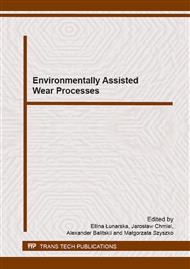[1]
M.S. Plesset, R.B. Chapman, Report No. 85-09, Office of Naval Research 1970., (1970).
Google Scholar
[2]
J. Chmiel, J. Steller, A. Krella, W. Janicki, Badania zużycia korozyjno-kawitacyjnego na stanowisku wibracyjnym ze spoczywająca próbką, Probl. Eksploat. 1 (2010) 91–100.
Google Scholar
[3]
W. Beck, J.O. Bockris, J. McBreen, L. Nanis, Hydrogen Permeation in Metals as a Function of Stress, Temperature and Dissolved Hydrogen Concentration, Proc. R. Soc. Lond. A 22. vol. 290 (n. d. ) 220–235.
DOI: 10.1098/rspa.1966.0046
Google Scholar
[4]
A. Zielinski, E. Lunarska, M. Smialowski, The interaction of hydrogen atoms and dislocations in irons of different purity, Acta Metall. 25 (1977) 551–556.
DOI: 10.1016/0001-6160(77)90194-8
Google Scholar
[5]
T. Boellinghaus, H. Dangeleit, A. Hoffmeister, A scatterband for hydrogen diffusion coefficients in microalloyed and low carbon structural steels, Weld. World / Le Soudage Dans Le Monde. 35 (1995) 149.
Google Scholar
[6]
A. Atrens, N. Winzer, G. Song, W. Dietzel, C. Blawert, Stress Corrosion Cracking and Hydrogen Diffusion in Magnesium, Adv. Eng. Mater. Volume 8, (n. d. ) 749–751.
DOI: 10.1002/adem.200600050
Google Scholar
[7]
J. Toribio, Role of hydrostatic stress in hydrogen diffusion in pearlitic steel, J. Mater. Sci. 28 (1993) 2289–2298.
DOI: 10.1007/bf01151655
Google Scholar
[8]
S. Hirnyj, V. Skalsky, L. Botvina, The Effect of Electrolytically Absorbed Hydrogen on Young ' s Modulus of Structural Steel, in: ECF 19 Proc., (2012).
Google Scholar
[9]
E. Lunarska, K. Nikiforov, E. Sitko, Stress corrosion cracking of bainite 0. 3C-1Cr-1Mn-1Si-1Ni type steel in acid rain simulated solution, Werkstoffe Und Korrosion. 54 (2004) 373–380.
DOI: 10.1002/maco.200303747
Google Scholar
[10]
E. Lunarska, O. Chernyayeva, Spivak L., Hydrogen-straining effects in Al, J. Alloy. Compd. 404-406C (2005) 269–272.
DOI: 10.1016/j.jallcom.2005.02.094
Google Scholar
[11]
O. Balytskiiy, J. Chmiel, P. Krause, J. Niekrasz, Role of hydrogen in the cavitation fracture of 45 steel in lubricating media, Mater. Sci. 45 (2009) 39–42.
DOI: 10.1007/s11003-010-9227-y
Google Scholar
[12]
B. Baranowski, Diffusion in Elastic Media with Stress Fields, in: S. Sieniutycz, P. Salomon (Eds. ), Adv. Thermodyn., Flow, Diffus. Rate Process., Taylor and Francis, New York, 1992: p.168–199.
Google Scholar
[13]
R.J.K. Wood, J.A. Wharton, A.J. Speyer, K.S. Tan, Investigation of erosion – corrosion processes using electrochemical noise measurements, Tribol. Int. 35 (2002) 631–641.
DOI: 10.1016/s0301-679x(02)00054-3
Google Scholar
[14]
Y.G. Zheng, S.Z. Luo, W. Ke, Cavitation erosion-corrosion behaviour of CrMnB stainless overlay and 0Cr13Ni5Mo stainless steel in 0. 5 M NaCl and 0. 5 M HCL solutions, Tribol. Int. 41 (2008) 1181–1189.
DOI: 10.1016/j.triboint.2008.02.011
Google Scholar
[15]
J. Chmiel, E. Łunarska, Effect of Cavitation on Absorption and Transport of Hydrogen in Iron, Solid State Phenom. 183 (2012) 25–30.
Google Scholar
[16]
J. Skrzypek, A. Baczmanski, W. Ratuszek, E. Kusior, New approach to stress analysis based on grazing-incidence X-ray diffraction, J. Appl. Crystallogr. 34, part 4 (n. d. ) 427–435.
DOI: 10.1107/s0021889801005404
Google Scholar
[17]
J. Chmiel, N509 2925 35 Report. Grant of Polish Ministry of Science and Higher Education Zużycie korozyjno - kawitacyjne i wodorowo - kawitacyjne materiałów stosowanych w budowie środków transportu, (2010).
Google Scholar
[18]
M.S. Plesset, A. Prosperetti, Bubble Dynamics and Cavitation, Annu. Rev. Fluid Mech. 9 (1977) 145–185.
DOI: 10.1146/annurev.fl.09.010177.001045
Google Scholar
[19]
M. von Smoluchowski, Bull. Int. Acad. Sci. Cracovie, Bull. Int. Acad. Sci. Cracovie,. 184 (1903).
Google Scholar
[20]
L. Chincholle, F. Goby, Etudes de la Charge electrique des bulles de cavitation. Application eventuelle a la detection se seuil de cavitation, in: Two Phase Flow Cavitation Power Gener. Syst., Grenoble, 1976: p.137–143.
Google Scholar
[21]
A. Barbulescu, V. Marza, Electrical Effects Induced At The Boundary Of An Acoustic Cavitation Zone, Acta Phys. Pol. B. 37 (2006) 508–518.
Google Scholar
[22]
O.I. Balyts'kyi, J. Chmiel, L. Dorobczyński, Analysis of electrochemical oscillations under conditions of vibration cavitation, Mater. Sci. 47 (2011) 21–25.
DOI: 10.1007/s11003-011-9363-z
Google Scholar
[23]
B.G. Gireń, J. Steller, Random multistage input and energy partition approach to the description of cavitation erosion process, Stoch. Environ. Res. Risk Assess. 23 (2009) 263–273.
DOI: 10.1007/s00477-007-0200-8
Google Scholar
[24]
H.M. Nykyforchyn, O.Z. Student, Influence of Hydrogen on Formation of Fatigue Tresholds in Structural Steels, Materials Science, Vol. 37, No. 2. 2001, pp.252-263.
Google Scholar


